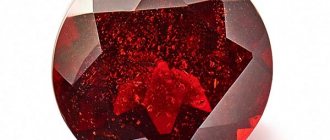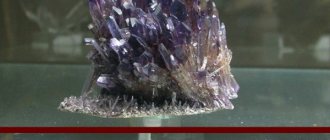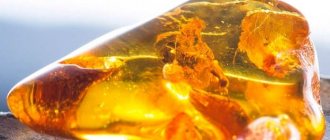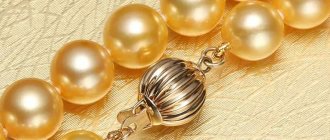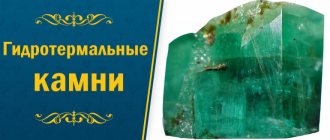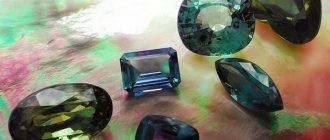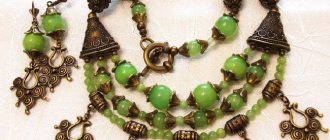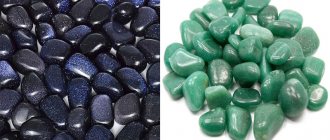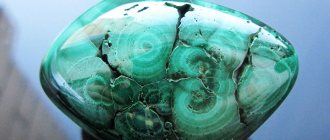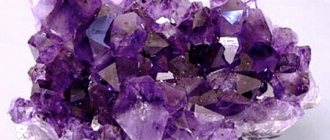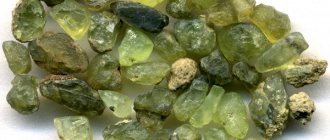Good afternoon, dear readers! Do you have turquoise jewelry? Are you sure of its authenticity? This question has good reason. The fact is that for many centuries this stone has remained one of the most popular and beloved, and therefore it is not surprising that there are such a large number of fakes of an unusual gem on the market - scammers have no qualms about taking advantage of the increased demand for the mineral. In this article we will tell you how not to be deceived - how to distinguish turquoise from a fake.
Characteristics of gems
Turquoise is a semi-precious mineral. Everyone strives to acquire it, because it is believed that the stone is a symbol of happiness and good luck.
Features of natural samples:
- rare examples of large whole breed;
- high price;
- wide color spectrum of blue shades;
- sufficient hardness – up to 6 units;
- complete opacity of the structure;
- shine is similar to wax objects;
- requires a certain temperature state of the environment;
- afraid of the humidity of the air environment;
- should not be left in direct sunlight;
- deteriorates from contact with chemical compositions of cosmetics.
Sea-green minerals are considered the most beautiful, but it all depends on the taste preferences of the buyer. Some people prefer pale and delicate blue products, while others will choose rich blue.
Who is suitable according to their zodiac sign?
According to astrologers, howlite is suitable for Virgo, Taurus, Capricorn and Scorpio. The gem influences them in such a way that representatives of these zodiac signs immediately feel a surge of strength and energy. The stone attracts good luck, promotes career success, helps to make only the right decisions, enhances positive character traits and neutralizes negative ones.
Ways to distinguish pressed types of gems
Real turquoise can be found in jewelry in the form of a pressed material. They are inexpensive. The stone is broken into crumbs, which are then combined with substances that perform painting and gluing of particles - resins. The workpiece turns out bright and interesting. In color it will be inferior to natural samples. Such gems remain popular and in demand. It is not difficult to distinguish a craft if you know several testing methods.
- Glass. When a glass product hits a surface or other glass, it produces a special, specific sound. Glass clinking distinguishes a fake.
- Plastic. You can check the plastic with a hot needle. It will either be punctured or melted.
It is difficult to counterfeit small beads, approximately 0.5 cm. Large pressed products are easier to counterfeit.
What tools will help determine the authenticity of a gem:
- Wet wipes. The mineral in the jewelry is wiped with damp cloths. If the napkin changes color, it means the material has been dyed. Natural turquoise is not afraid of water.
- Cotton wool and alcohol. Sometimes coloring is done efficiently. Then there will be no traces of water on the fabric or paper. You can wipe the surface of the product with alcohol. Fake minerals leave a mark in the form of a stain. The natural stone will remain unchanged.
- Matches. The most effective method is an open flame. But such an experiment must be carried out very carefully. If the product is made from counterfeit materials, it will melt. In addition, the fake emits an unpleasant odor. A natural gem turns pale when exposed to hot objects, and resin or wax appears on top. Chalcedony and glass materials decrease in size and are erased, but there will be no scratches on the top layer.
More often than not, jewelry made from turquoise stone looks very beautiful. I don't want to expose the product to damage. Therefore, I want any check to be gentle. An ordinary magnifying glass or microscope will be such an assistant. Natural turquoise is porous in structure. The changes will indicate what breed is being studied.
What to pay attention to:
- small bubbles - glass;
- veins darker than the main color - fake;
- dark spots – magnesite treated with salt or copper;
- high density – lazulite;
- bright glass luster – variscite.
How to check authenticity at home
If the jewelry has already been purchased, but the nature of the origin of the stones is in doubt, then more accurate and extreme methods of determining originality are used: heating or testing for strength. These methods are applicable at home because they entail damage to the mineral, which the store seller will not allow.
Ways to check the origin of a stone:
- Decoration made from plastic or plastic is usually painted with paint that is not permanent. To determine authenticity, the product is thoroughly wiped with a cotton pad generously moistened with alcohol. Natural turquoise will not leave any trace, but imitation will stain the cotton wool.
- The correct test method is heating. The gem is held over the fire for several seconds to reveal the structure. The artificial mineral will have a characteristic burnt smell, while the turquoise will crack a little along the veins, but there will be no smell, and the howlite will remain without a single damage. In order not to spoil the product, the check is carried out from the reverse side of the decoration.
- It is safer to use a heated needle. They stick it into the surface of the stone and look at the result: the fake will melt, the colored mineral will lighten at the point of impact. Real turquoise will not change color, but stabilized or pressed turquoise will release a drop of impregnation at the injection site.
- To check its naturalness, the stone can be scratched with an awl or a needle. A slight scratch will appear on the turquoise, the plastic will fall off with white shavings, but howlite or chalcedony will not receive any damage.
Turquoise is a semi-precious stone; due to its beauty and rarity, it is often counterfeited, so when purchasing, you should be careful and careful not to be deceived. You should only purchase jewelry with minerals from trusted sellers. If in doubt, simple ways to determine the authenticity of a gem will help.
Types of non-original gems
Varieties of fakes have been known since antiquity. There are more and more technicians. To avoid becoming the owner of an unnatural product, you should know the types of stones.
- Viennese turquoise. The pressed composition is made of malachite rock. Additional components are phosphoric acid and aluminum hydroxide. All components go through crushing and processing at high temperatures. The hardness of the Viennese type is lower than the natural samples. When heated, such a gem melts and turns black, and the original rock cracks.
- Neolithic. Synthetic turquoise appeared among fakes in the last century. The stone is visually attractive, like a genuine one. Externally, the material is blue, with sinuous veins. The blue layer is continuous and uniform. The rock contains chemical elements: copper Cu, iron Fe, bayerite. The characteristics of the Turquoise Neolithic are identical to the Viennese type of rock.
- Artificial turquoise. The structure of the stone is fragile, the hardness reaches up to 2.5 units. For counterfeiting, they take grains of the original blue and white colors. They are mixed with alkyd resin. The technique for creating an artificial mixture was developed in the USA, but it spread throughout the world very quickly.
Synthetic turquoise is used quite often in jewelry. Some craftsmen do not hide the origin of the material, others offer jewelry, presenting it as genuine and original. It all depends on the master, his attitude to the quality of his products and his reputation.
Imitation turquoise
5) IMITATION TURQUOISE (Imitation turquoise) is not turquoise at all, but either
a) natural minerals colored in the mass, or
b) artificial materials that imitate the color of natural turquoise.
Turquoise has always encouraged stone cutters to look for similar minerals that, in their natural form or after artificial coloring, could be used in jewelry instead of turquoise. Back in 1546, Agricola wrote: “No other precious stone can be so indistinguishably imitated as turquoise...”. Now there are about twenty such minerals. Minerals such as howlite, magnesite, cachalong, chrysocolla, low-grade lapis lazuli, chalcedony, and jasper are often used as natural imitations of turquoise. There are imitations made of fired plaster and alabaster. Also, turquoise is very often counterfeited with plastic (it melts and stinks when heated, it is not porous), surface staining with copper of bone and similar materials (white inside, the method of separation is the ability of organic matter to burn), glass and porcelain, etc.
Glass samples and cheap fakes
Glass is considered the oldest method of replacing the original. Turquoise beads were found in the tomb of Tutankhamun. The date of creation of the beads is 1350 BC. Today the method has not lost popularity. To create a rich blue palette, you will need cobalt.
In addition to the well-known glass base, they learned to fake it from other, more modern materials:
- Silicate formation. Enamel is mixed with metal oxides and glass. The densities of the samples are much higher than those of genuine rocks.
- Plastic. The cheapest jewelry is made from plastic. Small cabochons are cast, and a turquoise pattern is placed on the top layer. The color of the plastic is brighter, the color palette spreads evenly. The glossy shine is attractive and gentle. It is not difficult to recognize plastic; more often it looks unnatural, and somewhat flashy and pretentious.
Similar minerals
Several mineral rocks are similar to turquoise and can be substituted for genuine samples.
Variscite
Hardness reaches 5 units. The color palette is richer than that of turquoise. In nature, in addition to blue flowers, there are yellow and green gems. Variscite can be recognized by the surface of the mineral: a characteristic top layer in the form of a crust; sometimes there are individual small crystals on the surface, like growths.
Lazulite
Blue spar does not contain copper, which introduces a blue tone and greenish tints. Lazulite contains aluminum phosphates. The base of the mineral is fine-grained; the distinguishing feature of turquoise is the secretive crystalline lattice of the rock.
Howlite, chalcedony and quartz
They try to counterfeit rocks that are not initially similar to turquoise. Such stones are colored artificially. Minerals are lower in cost, but brighter than the original. The original gem differs from howlite in density; it is softer and more pliable. Quartz is more transparent, chalcedony is heavier. Artificial fakes do not have pores, which are always present in natural rocks.
Ondolite
The natural blue gem was replaced with ondolite in ancient times. Ondolite is an organic formation. These are fossils of fossil animals: teeth, bones. Externally, it is almost impossible to determine which of the samples is the original. But a detailed examination reveals organic origin. Ondolite dissolves in hydrochloric acid.
Healing properties of the stone
The fact that howlite is very beneficial for health is recognized by all doctors, including supporters of only traditional treatment. After all, the mineral contains calcium. It provides howlite with certain physical properties and is important for the formation of bones. If you wear an unpainted stone for fractures, dislocations, or cracked bones, they will heal faster.
Lithotherapists also name other useful features of howlite:
- The gem will help pregnant women get rid of toxicosis, mood swings, and attacks of eclampsia. Thanks to him, you will be able to safely carry and give birth to a healthy baby.
- If you wear the stone during flu epidemics, it will increase your immunity. It will be easier for people who have already “caught” ARVI or another cold to recover. To do this, it is advisable to wear howlite in the form of a pendant or beads.
- The mineral is able to strengthen the walls of blood vessels. It also reduces the risk of complications from coronary heart disease, hypertension, heart attacks and strokes.
A howlite talisman will help young children grow strong and healthy.
When painted, the stone loses its energy and becomes useless. A gem painted with turquoise or coral is simply a beautiful decoration. If you plan to use howlite for treatment, only natural, unprocessed mineral will suit you.
Masseurs also love howlite. A soft and warm pebble helps relax muscles, warms up the body and prepares it for therapeutic effects. The stone is especially good for the following types of massage:
- Anticellulite massage. The gem effectively removes the notorious “orange peel” from the thighs and buttocks.
- Anti-varicose. Howlit helps to first slow down the development of the disease, and then completely stop it. The stone also promotes the healing of trophic ulcers and reduces spider veins.
- Massage for atherosclerosis. Howlite effectively removes blockages in blood vessels, lowers blood pressure and cholesterol levels.
- Antirheumatic. The mineral reduces swelling and reduces the intensity of joint inflammation. In the future, it eliminates pain and stiffness of movement.
There is an opinion that howlite helps get rid of toothache. If you carefully apply it to the affected area, the suffering will decrease, and the tooth enamel will begin to recover.
Stages of checking for originality
A competent jewelry maker will help you avoid buying an imitation. He will also warn that after additional checks it will be revealed that the product is a scam, it can be returned and the money spent will be returned. Jewelers have developed tips that make it easy to verify the authenticity of a purchase.
- Check connection openings. They must match the color of the main tone of the stone. Any difference: whiter, darker is a sign of a fake.
- Learn about the method of processing the mineral. The pressed one goes through a special impregnation, the refined one goes through painting. Such gems are not fake; the seller is obliged to provide information about the method, because they require special care.
- View through a magnifying glass. Under a magnifying glass there will often be types of defects that are not typical for blue gems: color inclusions, cracks, bubbles.
- Wipe with a damp cloth. Check for stains; they appear on an unnatural sample.
- Rub with wool. A genuine product will attract the remains of napkins and lint to the surface.
- Check for density. Touch the decoration with a hot needle. Imitation will more often give off an unpleasant odor, similar to the smell of singed hair. The appearance of the original does not lose its attractiveness and does not frighten you with its pungent aroma.
- Mineral insert size. It should be remembered that there are no large specimens in nature.
- The shine of the product. The gem has a waxy glow; porcelain or glass makes one suspect deception.
For counterfeit jewelry, they do not issue certificates or specify where the gem was mined, so the easiest way is to request documents for the goods.
Magical properties of howlite
As with its healing properties, howlite’s magical powers are lost if the gem is painted. Natural white and bluish stones are identical from the point of view of magic. The meaning of the gem is calm, purity, innocence and chastity. Its unclouded color will attract strength to you and help you find peace.
- The mineral can clear the mind of negative thoughts. Meditation on it can relieve a person from depression, anxiety, excessive conflict and irritability.
- The magical properties of howlite stone attract mediums and spiritualists. The gem improves communication with the other world. It happens that he himself sends the soothsayer pictures of the future.
- If you practice lucid dreaming or out-of-body experiences, place a stone under your pillow. It will help you not to get lost in the world of illusions.
- The stone is also recommended for those people who are looking for new knowledge and mystical experience. Thanks to him, they will learn to filter out unnecessary information, become more diligent and learnable.
- It is also easier to obtain rational, scientific knowledge if you first meditate on the mineral. Therefore, howlite is well suited for students and researchers.
- The mineral will help overcome fear of the public and criticism, so it can be worn by public people - politicians, businessmen, actors.
The gem can improve public speaking abilities.
If you have a serious meeting coming up, take howlite with you. He will help you get together and calmly withstand a difficult situation. The gem is able to win over your interlocutor and make him more receptive to arguments and reasons.
Thanks to the howlite talisman, you can always achieve success. But it is worth remembering that the stone really does not like careless treatment. If the wearer stops taking care of it, the amulet can also bring misfortune.
